Psycho Bio Chapters 9,11,12,13
1/168
There's no tags or description
Looks like no tags are added yet.
Name | Mastery | Learn | Test | Matching | Spaced |
|---|
No study sessions yet.
169 Terms
Health Consequences of Obesity
Hypertension
Sleep Apnea
Arthritis
Peripheral Artery Disease
High Cholesterol & Triglycerides
Coronary Heart Disease (also caused by diabeties)
Diabeties
Diabetic Complications
Social Disability
Obesity is ranked as…
One of the top 5 health problems in developed nations according to the World Health Organization
Mortality Rates & BMI
thinner people live longer.
very thin people do not have the lowest mortality rates.
Body Mass Index (BMI)
Is used as a measure of body fat
BMI = body weight/ (height²)
body fat may be overestimated for those with more lean body mass (e.g., athletes)
body fat may be underestimated in those with less lean body mass (e.g., the elderly).
Obese
BMI >/= 30 kg/m²
More than 1 in 3 adults, aged >/= 20yrs (>60 million)
Morbidly Obese
BMI ≥ 40 kg/m2
more than 1 in 20 adults, aged ≥ 20 yrs (>9 million)
Claude Bernard (1813-1878)
French psychologist who is considered the “father” of modern experimental psychology
Studied the physiology of digestion, particularly the role of the pancreas
Contributed to the understanding of glucose regulation in the liver
Claude Bernards Finding on Weight Regulation
Weight is regulated homeostatically
Proposed the concepts of:
Homeostasis = controlled stability of the ‘internal milieu’ (i.e., internal environment) of cells & tissues
Feedback control loops = explained how certain systems work as homeostatic mechanisms
Homeostasis of Biological Processes
Keeps certain target body variables at a specific SET POINT or within a fixed range
Ex: body levels of water, oxygen, pH, glucose, sodium chloride, protein, fat.
Homeostasis - Negative Feedback Processes & Body Weight
Bio-mechanisms that reduce discrepancies from the set point are known as NEGATIVE FEEDBACK PROCESSES
For many years it was hypothesized that obesity was a consequence of a failure of body weight homeostasis
Hunger
Is the stimulus that drives our need to eat
When our bodies need fuel, signals are sent from the empty stomach & intestine that trigger feelings of hunger
Signals of Hunger & Satiety are processed by what?
processed by the brain but we can override them:
delay hunger response actions e.g., people who fast or starve typically have lower hunger
Eat more than we need by ignoring satiety receptors that signal fullness e.g., “supersize me”
Digestive System
Function of the digestive system is to break down food into smaller molecules that the cells can use
Digestion Beginning
Begins in the mouth where enzymes in the saliva break down carbohydrates
Stomach & Proteins
Hydronic acid & enzymes in the stomach digest proteins
Small Intestine
Has enzymes that digest proteins, fats, & carbohydrates & absorbs digested food into the blood stream
Large intestine
Absorbs water & minerals & lubricates the remaining materials to be excreted
Satiety
Is the feeling of fullness that stops appetite & hunger signals
The brain regulates eating through messages from the mouth, stomach, intestines, fat cells & elsewhere
Satiety signals that originate in the stomach are delayed from the start of eating, so it is easy to overeat before satiety signals are received & acted upon
The LENGTH OF TIME FOOD STAYS IN THE STOMACH & INTESTINE affects the duration of satiety & initiation of hunger signals
Distention of the duodenum can also produce feelings of satiety
The duodenum releases cholecystokinin (CCK) & GLP-1 to restrict flow through the duodenum causing the stomach to slow gastric emptying.
Both CCK & GLP-1 signal the brain satiety mechanisms
Gastric bypass surgery
is the removal or sewing off of part of the stomach
Decreased stomach size allows distention of the stomach to produce satiety sooner
People who have had their removed surgically (e.g., cancer) still report satiety. So stomach distention is not the only satiety signal
Oral Factors in Terms of Hunger & Satiety Signals
The desire to taste & have other mouth sensations, such as chewing, are also factors in hunger & satiety
Persons who cannot swallow may have stomach feeding tube inserted
Food is then placed directly into the stomach but these persons report not feeling satisfied when fed;
They need to chew food to feel satisfied
So untasted meals are unsatisfying → cold diminish taste perception & food satisfaction
Foods high in protein have…
Foods high in protein have a high satiety value because they take more time to digest… thus, high protein diets are popular
Foods high in fiber have…
Foods high in fiber have a high satiety value because they stay in the stomach & intestine for longer periods of time than foods that contain concentrated sugars or highly processed foods that digest & absorb readily
People who consume quantities of whole grain products, vegetables & fruits often feel no hunger because their satiety signals remain “on”.
Foods high in fat have what? & what is the difference between Glucose & Fructose
Foods high in fat although calorie dense, have a low satiety value. They fail to trigger the satiety signals.
So we often over-consume high fat foods, which tend to have the most calories
Unfortunately, many high fat foods trigger appetite
Researchers once thought that all fat was bad, but we now know that they were wrong
Fat is a major source of energy & helps the body absorb essential vitamins
is it sugar? Glucose vs fructose; food high in fructose leads to fatty liver → insulin resistance → hunger & insulin levels increase → central obesity
Central deposition of fat (i.e., Central Obesity)
Heightens health risk.
You have dangerous excess visceral fat if your waist circumference at the level of the umbilicus is more than half your height.
Stomach Wall Stretching
With eating is conveyed by the vagus nerve to the brain
The splanchnic nerves convert info about STOMACH NUTRIENT CONTENT
In between meals,
INSULIN LEVELS ARE LOW: hunger increases
GLUCOSE LEVELS ARE LOW:
Glucagon released & liver cells convert glycogen back into glucose, which returns to the blood & slows the return of hunger
In Type 2 diabetes, INSULIN RESISTANCE (IR) occurs:
IR is the decreasedability for insulin to get glucose into body cells
More insulin needs to be secreted to get the job done
EARLY after type 2 diabeties onset…
To overcome the insulin resistance, after eating, the body releases high levels of insulin
So the person typically experiences:
Weight gain
LATE in Type 2 diabetes,
As the body is not able to produce enough insulin, not enough glucose is able to enter the cells
so the person typically experiences:
More hunger
A loss of weight [wasting]
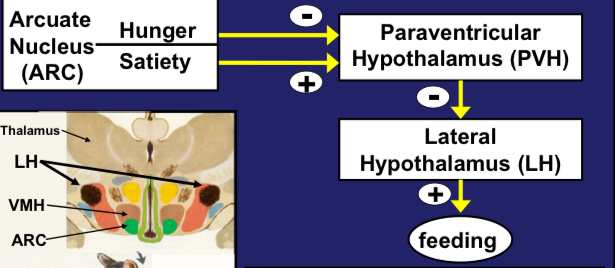
Hypothalamic Mechanisms of Eating
Damage to the Lateral hypothalamus (LH) results in loss of appetite
The paraventricular hypothalamus usually inhibits the LH to prevent feeding
Feeding occurs when the Arcuate Nucleus (ARC) inhibits the PVH, thereby releasing the LH
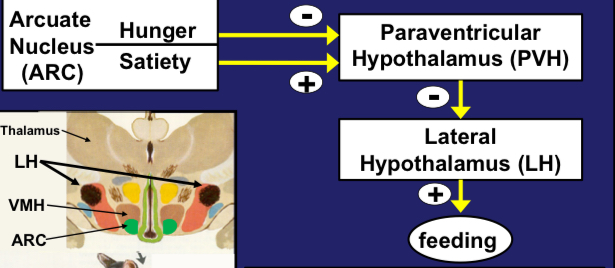
CNS Eating Mechanisms (ARC)
The ARCUATE NUCLEUS (ARC) IN THE HYPOTHALAMUS has 2 sets of neurons that detect either HUNGER OR SATIETY SIGNALS
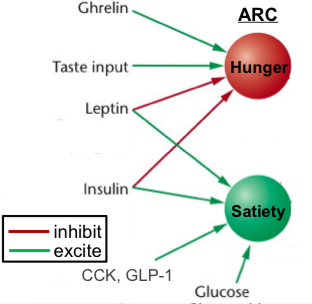
CNS Eating Mechanisms PT.2
Output from the ARC goes to the PARAVENTRICULAR NUCLEUS OF THE HYPOTHALAMUS (PVH)
When ARC hunger-sensitive neurons inhibit PVH, eating occurs
When ARC satiety-sensitive neurons excite the PVH, eating stops

What is the name of the Satiety signals from ARC to PVH:
EXCITATORY TRANSMITTER melancortin
Signals that trigger hunger
taste pathways
Decrease in leptin levels
GI release of ghrelin (Ghrelin rises before a meal to signal hunger & triggers stomach contractions.)
Signals that trigger satiety
GI distention triggers CCK release
Increase in leptin levels
Increase in blood glucose & insulin levels
Leptin Hypothesis in Terms of its Effects on Obesity
High leptin normally inhibits hunger
some obese persons have a genetic inability to produce leptin (LEPTIN SYNTHESIS DEFICIT) → more hunger
Some obese persons display less sensitivity to leptin (LEPTIN RESISTANCE)
I.e., they perceive less leptin than actually is present → more hunger
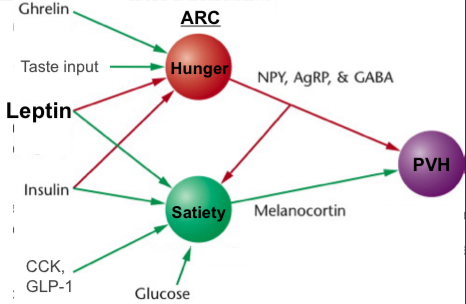
Melanocortin Hypothesis
Melanocortin normally excites the PVH to inhibit the LH & stop eating.
Some obese persons have a MUTATED MELANOCORTIN RECEPTOR GENE
So they overeat & become obese because their PVH is not able to receive the satiety signal
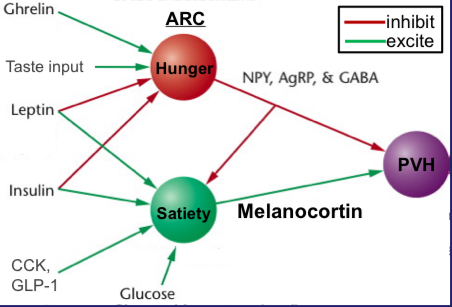
Overall Neurobiological Model of Eating
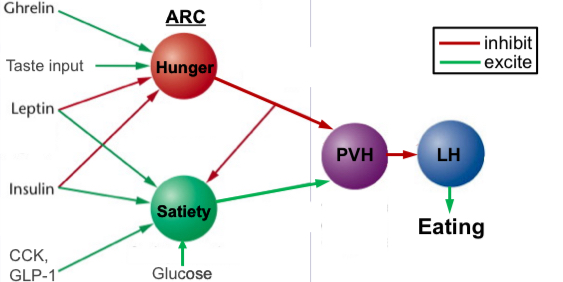
Conclusion
Body weight is the 2ND HIGHEST HERITABLE TRAIT
So their is a very strong genetic message demanding that our body weight will be similar to our parents
There are EXPLICIT NEUROBIOLOGICAL MECHANISMS that account for why we regulate body weight around a set point range
Of all the machinists that are known, WILL POWER, is NOT very likely to be one of them
When we BETTER UNDERSTAND THE INTERACTIVE NEUROBIOLOGICAL MECHANISMS UNDERLYING EATING, it will be possible to design interventions to help overweight & obese persons maintain a healthier body weight
Energy Balance & Body Weight Hypothesis
All of us have short-term weight fluctuations. This is normal ... but weight is regulated tightly within a set point range.
However, when weight consistently increases or decreases, we have an energy imbalance.
Apetite
is another signal to eat.
We can have an appetite for food with or without hunger.
Sights, smells, thoughts or discussion of foods may stimulate appetite.
Stress Eating
Research shows that the tendency to be overweight appears to be inherited is, but psychosocial factors, like stress, can play a role.
Stressful situations often stimulate appetite (“stress eaters”).
A prevailing notion is that food is comforting & especially so to those who are experiencing → episodic or chronic stress.
Thus, emotionally stressful situations may lead to periods of uninhibited, excessive ‘binge-like’ eating in susceptible individuals.
A combination of learned & unlearned factors contribute to hunger & eating behaviors.
Learned food selection is based on:
1) sweetness is safe;
2) familiarity is safe;
3) negative consequences ...
conditioned taste aversion can occur after just one bad exposure [i.e., most powerful learning mechanism].
In a healthy person, after eating
glucose levels rise: if not used, liver cells convert some of the excess glucose into glycogen; then fat cells convert it into fat.
insulin levels rise: released from pancreas & enables glucose to enter the cell; thus, blood glucose decreases & appetite decreases
Hunger signals from ARC to PVH:
inhibitory transmitters, neuropeptide Y (NPY), agouti-related peptide (AgRP) & GABA
So how does one become the fat mouse or be the thin mouse?
Hypotheses
1. Leptin synthesis deficit or receptor resistance
2. Melanocortin receptor malformation
3. VMH damage or malfunction [see Module 9.3 pg. 313-316]
Emotions
Emotions permit persons to react to situations in such ways that make their thoughts & feelings readily apparent(to others and oneself), when nothing is said.
Actions Alter Emotions
People holding a pen in their teeth, who were therefore forced to smile were more likely to report amusement than were people with a pen in their lips, who therefore could not smile
FACIAL FEEDBACK HYPOTHESIS
Facial expressions are not only the result of our emotions but can also influence our emotional experience
Emotions can:
ENHANCE COMMUNICATION with others and with oneself;
Color experience by FOCUSING ONE’S ATTENTION in certain directions or MOTIVATE a person to behave in particular ways
Psychologists define emotion in terms of a…
TRIPARTITE MIND-BODY INTERACTION
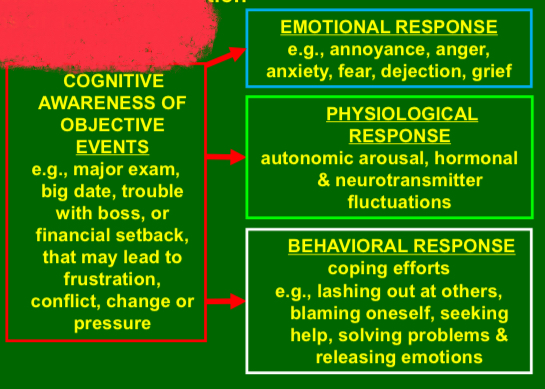
The brain uses the…
AUTONOMIC NERVOUS SYSEM to convert the physiological response occurring during emotional expression
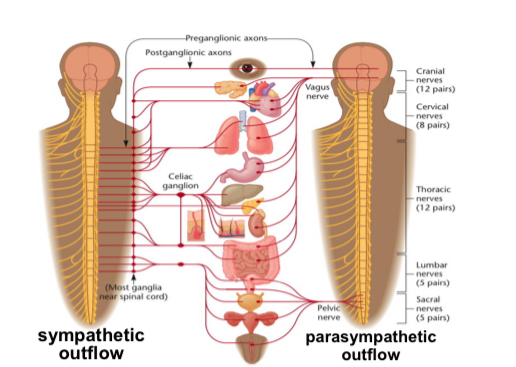
Theories of Emotion
Common Sense Theory
The common sense theory of emotion suggests that initially we perceive an emotion & from the emotion, a specific pattern of autonomic arousal & skeletal action occurs

James Lange Theory of Emotion (1884)
The James-Lange theory of emotion suggest that the autonomic arousal & skeletal action occurs first
Then the emotion that occurs is the label that we give the specific arousal of the organs & muscle
The greater the physiological arousal the more intense the emotion
Main contribution: the experience of emotion may involve “reading” the state of one’s own body

The Cannon-Bard theory of emotion (1927)
the emotion is produced in the brain alone.
An emotion is mediated via brain activity following recipes & processing of sensory information
Thus, the emotional cognition & the autonomic arousal & skeletal action occur simultaneously

The Schafer-Singer 2 factory theory (1962)
relatively non specific feelings of physiological arousal occur & then emotional labels are attributed to them
These attributions occur by CNS systems that interpret the current social, physical & cognitive situation
So the physiological response is a cue to the brain that something important may be happening to us

Schacter-Singer - The vitamin “Suproxin” study
Schacter-Singer - The vitamin “Suproxin” study: Hypothesis
Would participants be deceived into experiencing an emotion based on the available “cognitive circumstance” in the absence of an appropriate explanation for arousal?
Schacter-Singer - The vitamin “Suproxin” study: Study Design (2 × 3 × 2)
epinephrine vs placebo
Informed vs ignorant vs misinformed
Cognitive circumstance: eutrophication vs angry confederate
Measured self-reported mood before & after being with the confederate
Schacter-Singer - The vitamin “Suproxin” study: Findings
Placebo - reported no emotional change.
Epinephrine - persons who had no explanation for their physical arousal (i.e., in ignorant & misinformed conditions), looked to their context for an explanation for what they were experiencing
If they were with the happy stooge, they felt happy
If they were with the angry stooge, they felt upset
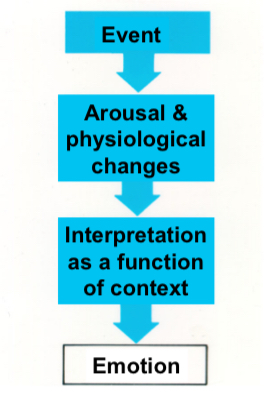
Schacter-Singer - The vitamin “Suproxin” study: Conclusions
Interpretation of physical states (facial expressions, physiological changes) are key components of emotion mechanics
Interpretation of the situation context is a key determinant of emotion mechanics
However, the brain can also generate emotion without added input from the body e.g., quadriplegic (paralyzed persons feel emotions)
Brain Representations of Emotion
emotional experiences arouse many areas of the brain
the LIMBIC SYSTEM & THE FOREBRAIN areas are considered critical for producing emotion
PET & fMRI studies also suggest many of the other areas of the cerebral cortex, especially the frontal & temporal lobes, are activated during an emotional experience
The right hemisphere seems to be more responsive to emotional stimuli than the…
The right hemisphere seems to be more responsive to emotional stimuli than the left
Viewing pictures of emotional facial reactions (anger, fear, happiness, disgust, sadness) Tends to activate right temporal cortex more than left
Damage to the right temporal cortex causes deficits in identifying emotional expressions of others
Limbic System
The limbic system consists of a number of interlinked structures that form a border around the brain stem
Mediates emotion, motivation, aggression, learning and memory
James Papez (1883-1958)
Papez hypothesized that EMOTIONAL EXPERINCE was primarily determined in the cingulate gurus & prefrontal cortical regions
But EMOTIONAL EXPRESSION was thought not to be a function of one specific brain center but the result of a circuit of limbic system structures
Phineas Gage
A railroad foreman for Rutland & Burlington Railroad in central Vermont in 1848
Suffered a terrible accident — an explosion sent a tamping rod through his brain
Connections from frontal lobe to limbic system were severed by the tampering rod
What happened to Phineas Gage because of the rod
Normally inhibitory connections from frontal lobe to the limbic system suppress its emotional suggestions
Serotonin is the neurotransmitter
Low brain serotonin release is associated with history of impulsiveness, violent crimes, depression, & suicidality
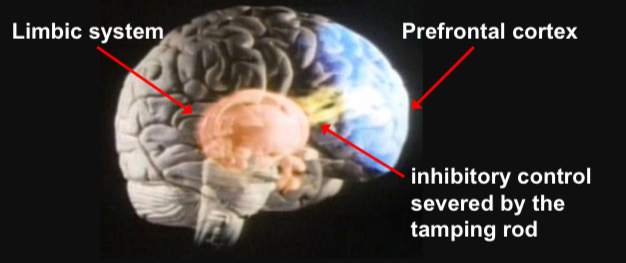
What happened to Phineas Gage because of the rod PT.2
Damage to the prefrontal cortex can impair decision making & results in hyper-emotionality
Gage’s case is an illustration of the CNS organizational principle that HIGHER ORDER STRUCTURES INHIBIT LOWER ORDER STRUTURES
The loss of prefrontal cortex control leads to impulsive decision-making without pausing to consider consequences
Stems from failure to anticipate the unpleasantness of an outcome
Attention Deficit Hyperactivity Disorder (ADHD)
6.1 million in Us; 1 in 8 boys; 1 in 18 girls
Core symptoms include:
Distracitbility, impulsiveness, hyperactivity; especially in tasks involving executive control (response inhibition, working memory)
Name may be a misnomer because children usually have very good attention spans
Decreased connectivity in a fronto-straieto-parieto-cerebellar network
Delay in PFC cortical development
treated with seretonin reuptake inhibitors (SSRI) & methylphenidate (Ritalin) to block reuptake of seretonin & dopamine → enhances inhibition of limbic system & motor cortex
Representation of Emotion as 3-Dimensions
Right-hemisphere junction where the temporal lobe meets the parietal cortex is activated when watching an emotionally charged movie (Lettieri et al., 2019). •
Researchers used moment-to-moment ratings & fMRI to show that emotions are coded within 3-dimensions:
Polarity = pleasure vs. displeasure
Intensity = high vs. low
Complexity = conflict (inner conflict & ambivalence) vs. unambiguous (more certain emotion)
Amygdala & Fear
The amygdala has been implicated as a key structure in the mediation of fear
Amygdala responds more strongly to an angry face directed away & to a frightened face directed toward you
Amygdala responds more strongly to expressions that are more difficult to interpret
Damage to the Amygdala
Damage to the amygdala interferes with:
Learning of fear responses
Retention of previsult learned fear responses
Interpreting stimuli with emotional consequences, in particular stimuli that are threatening
Many of our body’s alarm circuits are grouped together & linked to the amygdala
Informs of potential dangers in the environment
Diagram:

Summary
Emotions include a tri-partite process (affect, physiological arousal, behavior) that involves an interaction of the prefrontal cortex & the limbic system & the evaluation of the emotionally provocative experiences in terms of:
Polarity, intensity & complexity;
Detection of bodily responses (nonverbal behavior, physiological arousal);
appraisal of the context of these events & their meaning (Schafer & Singer)
Behavioral Medicine
The field of BEHAVIORAL MEDICINE is an extension of biopsychology onward health
It emphasizes the effects of emotions & other behaviors (diet, exercise, smoking, etc) on health & illness
One major focus of interest in behavioral medicine research has been the picture relationship between LIFE DISTRESS (e.g., dysphoria, perceived stress, anxiety) & DISEASE.
Behavioral scientists study the potential ways stress may affect diseases pathophysiology
Sources of Stress
Come from many directions, including: school, family, friends, strangers, & authorities
Major life events
Catastrophes
Daily hassles
Environmental (e.g., noise, population crowding & traffic)
Job related
Working Hypothesis of the Stress-Disease Relationship
Chronic &/or repeated acute stress adversely affects multiple physiological systems & contributes to disease pathophysiology more readily in susceptible persons
The Stress Stimulus
These are common elements to situations that may elevate stress responses in everyone
Novelty
Unpredictability
Threat to the ego
Loss of control
The Stress Response
Walter Cannon’s research (1932) on the “FLIGHT OR FIGHT RESPONSE” stimulated extensive research examine the bodily responses to stressors (e.g., temp extremes, O2 deficit, negative emotions)
This research helped to show that the mind & the body are not discrete & unrelated but in fact greatly influence each other
Walter viewed stress as a gift to be used wisely, enabling people to meet & overcome adversity
His research showed that major emotions involve the excitation of the sympathetic nervous system
Stress
The process by which we perceive & respond to events that are perceived as harmful, threatening or challenging
Stress is identified as one of the 10 leading occupational health problems in the US
Stress is a part of life
In fact, without stress our lives would be dull
But, WHEN STRESS OVERTAXES OUR COPING RESOURCES, it can damage our health
Stressor
Any event or situation that triggers coping adjustments
Allostasis
The adaptive process of achieving stability, or HOMEOSTASIS, through physiological or behavioral change → is essential for maintaining internal viability amid changing conditions
Allostatic load
Cumulative long-term effects of the body’s physiological response to stress
Both repetitive, acute & prolonged chronic stressors may contribute
Stress Induces the…
Flight or Fight Response
This prepares the body for handling brief emergencies
The response is mediated by the activation of hypothalamic-pituitary-adrenal cortex (HPAC) axis & the sympathetic-adrenal medulla (SAM) axis
Ex:
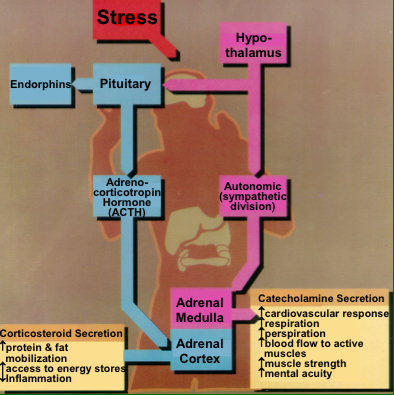
Hans Selye (1979) & Stress
Hans Selye (1979) defined stress as the NON-SPECIFIC RESPONSE of the body to any demand made upon it
Studied influence of stress on ability to cope with & adapt to the pressures of injury & disease
Discovered that a variety of ailments manifested in many similar symptoms, which he attributed to the body’s efforts to respond to stresses of being ill
He hypothesized that threats on the body activate a general response to stress called the GENERAL ADAPATION SYNDROME
When stressors are viewed as challenges, then they can lead to growth & enhanced functioning → he termed this “eustress” (good stress)
General Adaptation Syndrome Stages
Alarm Stage:
Acute increase in sympathetic nervous system activity
Resistance Stage:
sympathetic response declines, the adrenal cortex releases cortisol & other hormones that ENABLE THE BODY TO MAINTAIN PROLONGED ALERTNESS, FIGHT INFECTION & HEAL WOUNDS
Exhaustion Stage:
Occurs after prolonged stress & is characterized by inactivity, vulnerability, & decreased energy to sustain heightened responses
General Adaptation Syndrome: General Info
Long-term, inescapable stressors activate the GENERAL ADAPTATION SYNDROME,
Which in short-term is helpful, but in the long-term is harmful to our health
HPAC AXIS
The HPAC axis becomes the dominant response to prolonged stressors
Hypothalamus
Activation of the Hypothalamus induces the pituitary gland to secrete adrenocorticotropic hormone (ACTH)
ACTH
Stimulates the adrenal cortex to secrete cortisol
Cortisol
Helps to mobilize energies to combat a difficult situation; salivary levels are used as in index of stress
The Transaction Model (Lazarus & Folkman, 1984)
The STRESS depends as much on how an event is appraised as it does on the stressor event itself
Richard S. Lazarus, “Our emotions & thoughts are inextricably linked.”
Diagram:
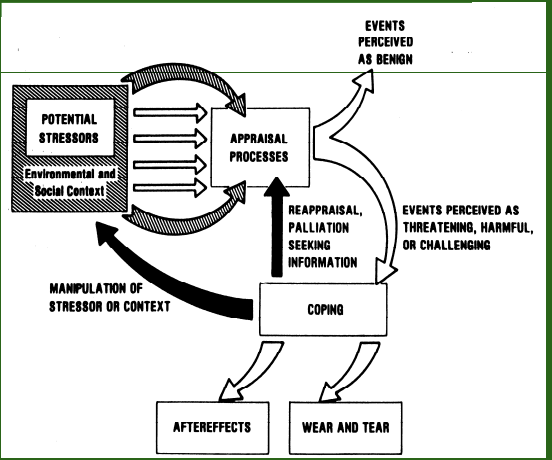
Psychoneuroimmunology
Study of the relationship of psychological & behavioral factors, immunity & changes in health status
Ader & Cohen (1975)
They were studying conditioned taste aversion to a sweet water solution after painting with a nausea-inducing drug using Pavlovian conditioning
Over the course of training, the rats learned to avoid the sweet water
But ader discovered a problem that the rats appeared to have a high infection prevalence
Puzzled by this development, they then force fed the rats with the sweet water, & a number of them became very sick
Then Ader discovered that the number of infection-fighting immune cells was significantly reduced
Ader & colleagues were the first to show that the CNS is capable of controlling the immune system
Ex:
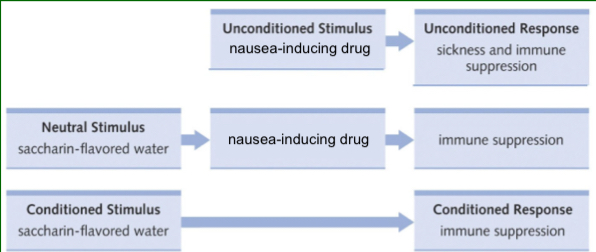
Subsequent Studies to Ader
Jemmott et al (1983)
dental students displayed decreased antibody (lgA in saliva) during EXAM STRESS than during vacations
Kiecolt-Glaser et al (1984
LONELY students had poorer immune function than non-lonely students during exams
Schleifer et al (1983)
BEREAVEMENT acutely depresses immunity in widowers
Cohen et al (1998)
exposed subjects to cold virus; those having 2 month or more of increased PERCEIVED STRESS were more likely to become infected
Immune response to infection
The immune response to infection involves inflammation as a necessary & helpful process
Ex:
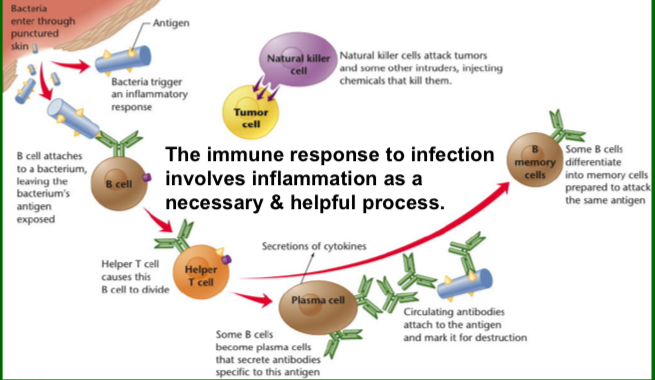
Stress & inflammation
Acute stress induces pronounced immune cellular migration into circulation, which helps to combat infection
Contained within the stress response is the release of substances that injures cells & causes the release of inflammatory cytokines
Inflammatory cytokines feed back to the brain & may produce symptoms of illness,
E.g., fever, sleepiness, lack of energy, etc..
sleep & inactivity are the body’s way of conserving energy to fight illness
Stress, inflammation & Negative Emotions
Inflammatory substances are linked with depression, fatigue & other negative emotions
Negative emotions contribute to greater risk for prolonged infection & delayed wound healing, which further fuels sustained inflammatory substance release
Where are memories stored in the brain
Early studies by Lashley & Penfield attempted TO FIND A LOCUS FOR WHERE MEMORIES ARE SORED
Later research confirmed that memories are stored throughout the brain in a distributed fashion, wherever the events are processed
Amnesia
Many kinds of brain damage, caused by disease or accident, impair learning & memory by causing amnesia
AMNESIA is the loss of memory
ANTEROGRADE AMNESIA refers to the inability to form NEW MEMORIES AFTER THE EVENT that caused the amnesia
RETROGRADE AMNESIA refers to MEMORY LOSS FOR INFORMATION OCCURRING PRIOR TO THE EVENT that caused the amnesia
Studies of amnesia patients help to clarify the distinctions among different kinds of memories & their mechanisms
The Case History of HM
In 1953, a patient, named HM, underwent an experimental brain operation at the Hartford Hospital to relieve his seizure disorder
William Scoville was the surgeon, who was very much influenced by Penfield who had done similar surgeries
Immediately after the operation, HM showed a profound ANTEROGRADE AMNESIA
His memory was “pure” & not accompanied by intellectual or personality disorders
To better understand the brain structures required for memory, HM became the topic of intense scientific study for more than five decades